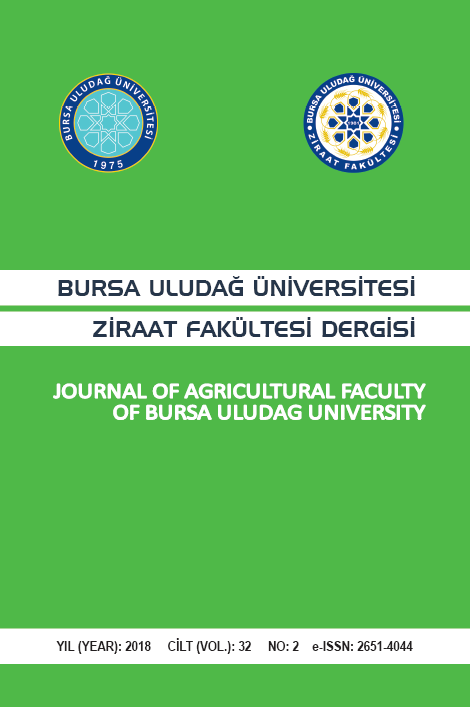Bursa İli Süt Sığırcılığı İşletmelerinin Biyogüvenlik Uygulamaları Açısından Değerlendirilmesi -I
Bursa ili, biyogüvenlik uygulamaları, süt sığırcığı işletmeleri, anket
Evaluation on Biosecurity Practices of Dairy Farms in Bursa Province -I
Bursa province, biosecurity practices, dairy farms, survey,
___
- Anonim, 2008. Biosecurity and Biological Risk Management for Livestock Enterprises, University of Florida. (Erişim tarihi: 12.10.2018).
- Anonim, 2018.http://traglor.cu.edu.tr/objects/objectFile/tcfdm9mU-2232013-48.pdf (Erişim tarihi: 20.12.2018).
- Barr, D. J. 2008. Analyzing ‘visual world’ eye-tracking data using multilevel logistic regression. Journal of memory and language, 59(4), 457-474.
- Barrington, S., Choinière, D., Trigui, M., and Knight, W. 2002. Effect of carbon source on compost nitrogen and carbon losses. Bioresource Technology, 83(3), 189-194.
- Bish, A. and Michie, S. 2010. Demographic and attitudinal determinants of protective behaviours during a pandemic: a review. British Journal of Health Psychology, 15(4), 797-824.
- Brennan, M. L. and Christley, R. M. 2013. Cattle producers’ perceptions of biosecurity. BMC Veterinary Research, 9:71.
- Buckner, C. D., Bremer, V.R., Klopfenstein, T.J., Erickson, G. E. Vander Pol, K.S., Karges, K. K. and Gibson, M.L. 2011. Evaluation of a prefermentation-fractionated by-product corn grain dry milling ethanol process in growing and finishing cattle diets. The Professional Animal Scientist, 27(4), 295-301.
- Callan, R. J. and Garry, F. B. 2002. Biosecurity and bovine respiratory disease. The Veterinary Clinics of North America. Food Animal Practice, 18(1), 57-77.
- Defra, 2002. Department for Environment, Food and, Rural Affairs.
- Ellis-Iversen, J., Cook, A.J.C., Watson, E., Nielen, M., Larkin, L., Wooldridge, M. and Enticott, G. 2008. The spaces of biosecurity: prescribing and negotiating solutions to bovine tuberculosis. Environment and Planning, 40: 1568–1582.
- Gordon, H.G., Oxman, A.D., Kunz, R., Vist, G.E., Falck-Yetter, Y. and Schünemann, H.J. 2008. What is “quality of evidence” and why is it important to clinicians? US National Library of Medicine National Institutes of Health. BMJ. Vol: 336.
- Heffernon, C., Nielsen, L., Thomson, K. and Gunn, G. 2008. An exploration of the drivers to bio-security collective action among a sample of UK cattle and sheep farmers. Preventive Veterinary Medicine, 87(3-4): 358-372.
- Hersom, M., Irsik, M. and Thrift, T. 2017. Biosecurity and Biological Risk Management for Livestock Enterprises. UF/IFAS Biosecurity and Biological Risk Management for Livestock Enterprises Handbook.
- Hoe, F. G. H. and Ruegg, P. L. 2006. Opinions and practices of Wisconsin dairy producers about biosecurity and animal well-being. Journal of Dairy Science, 89(6), 2297-2308.
- Koyuncu, M., Altınçekiç Ş.Ö. 2007. Çiftlik Hayvanlarında Refah. Bursa Uludag Üniv. Ziraat Fak. Derg., 21:2, 57-64.
- Köseman A. 2008."AB Müzakere Süreci ve Hayvan Refahı", Türktarım Dergisi, (ss.62-64).
- Köseman, A. and Şeker, İ. 2016. Malatya İlinde Sığırcılık İşletmelerinin Mevcut Durumu: II. Hayvan Sağlığı ve Ahır Hijyeni Perspektifinde Biyogüvenlik Uygulamaları. Kocatepe Veterinary Journal, 9(1): 61-69.
- Maunsell F. and Donovan G.A. 2008. Biosecurity and risk management for dairy replacements. Veterinary Clinics of North America: Food Animal Practice, 24(1):155-90. doi: 10.1016/j.cvfa.2007.10.007.
- Minitab Inc., 2014. (MINITAB release 17: statistical software for Windows) (Minitab Inc., USA).
- More, K. 2007. Scientific aspects of polymer electrolyte fuel cell durability and degradation, Chemical Reviews, 107 (10), 3904-3951.
- Negron, M., Raizman, E.A., Pogranichniy, R., Hilton, W.M. and Levy, M. 2011. Survey on management practices related to the prevention and control of bovine viral diarrhea virus on dairy farms in Indiana, United States. Prev.Vet.Med. 99,130–135.
- Oğuz, B., Özdal, N. ve Değer. S. 2016.Stomoxys (Diptera, Muscidae) sinekleri ve taşıdığı bazı önemli paraziter hastalıklar. Kocatepe Veterinary Journal, 9(2):97-104.
- Schemann, K., Taylor, M.R., Toribio, J.A. and Dhand, N.K. 2011. Horse owners’ biosecurity practices following the first equine influenza outbreak in Australia. Preventive veterinary medicine, 102(4), 304-314.
- Sibley, R. 2010. Biosecurity in the dairy herd. In Pract. 32, 274–280. doi:10.1136/inp.c3913.
- Smith, D. R. and Grotelueschen, D.M. 2004. Biosecurity and biocontainment of bovine viral diarrhea virus. Veterinary Clinics: Food Animal Practice, 20(1), 131-149.
- Sümbüloğlu, K., Sümbüloğlu, V. 2002. Biyoistatistik, Hatipoğlu Yayınları, Ankara.
- Talafha, A. Q., Lafi, S. Q., and Ababneh, M. M. 2008. The effect of estrus synchronization treatment on somatic cell count of transitional-anestrus Local-Damascus crossbreed goats’ milk. Tropical Animal Health and Production, 40(3), 185-192.
- Villarroel, A., Dargatz, D.A., Lane, V.M., McCluskey, B.J. and Salman, M.D. 2007. Suggested outline of potential critical control points for biosecurity and biocontainment on large dairy farms. Journal of the American Veterinary Medical Association 230: 808–819.
- Wallace, R.L. 2003. Practical and sensible dairy farm biosecurity. Proceedings of the 6th Western Dairy Management Conference _March 12- 14 2003_Reno NV- 202.
- Wells, S.J., Dee, S. and Godden, S. 2002. Biosecurity for gastrointestinal diseases of adult dairy cattle. The Veterinary Clinics of North America. Food Animal Practice, 18(1), 35-55.
- Yener, H., Atalar, B. and Mundan, D. 2013. Şanlıurfa ilindeki sığırcılık işletmelerinin biyogüvenlik ve hayvan refahı açısından değerlendirilmesi. Harran Üniversitesi Veteriner Fakültesi Dergisi, 2(2) 87-93.
- Yayın Aralığı: Yılda 2 Sayı
- Başlangıç: 1982
- Yayıncı: Bursa Uludağ Üniversitesi
Eda KILIÇ KANAK, Emine KIYAK, Suzan ÖZTÜRK YILMAZ
Atık Kayaçların Katı Çiftlik Gübresinin Gübre Özelliğine Etkisi
Küresel İklim Değişikliğinin Zeytin Yetiştiriciliği ve Zeytinyağı Üzerine Etkileri
Didar SEVİM, Nurhan VAROL, Oya KÖSEOĞLU
İklim Değişimi Sürecinin Sürdürülebilir ve Güvenli Gıda Üretimine Etkisi
Selin Özge DİNÇ, İbrahim Ender KÜNİLİ, Fatma ÇOLAKOĞLU
Cemal Faruk YILDIZ, Ramazan DOGAN
Bursa İli Süt Sığırcılığı İşletmelerinin Biyogüvenlik Uygulamaları Açısından Değerlendirilmesi-II
Bursa İli Süt Sığırcılığı İşletmelerinin Biyogüvenlik Uygulamaları Açısından Değerlendirilmesi -I
Süs Bitkilerinde Arbüskülar Mikoriza Kullanımı
